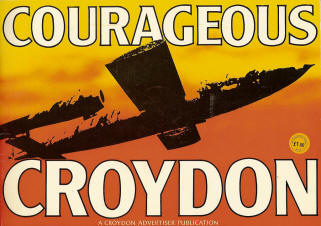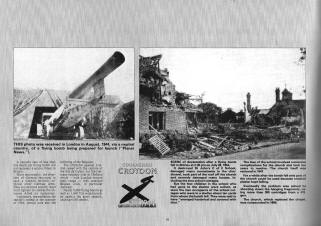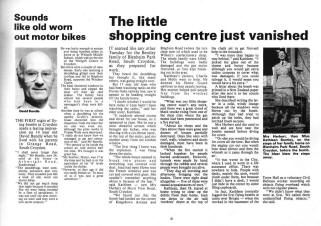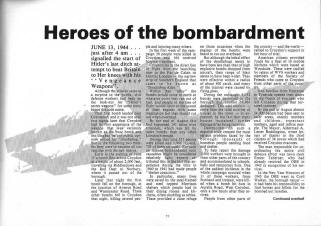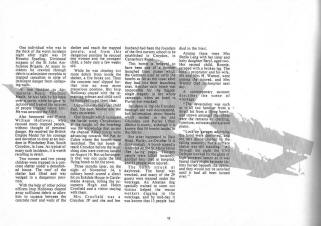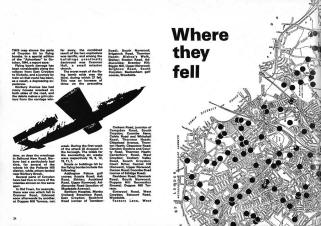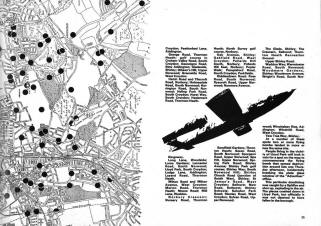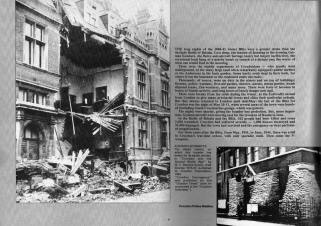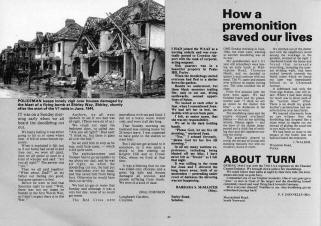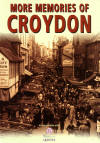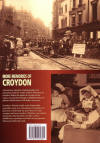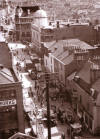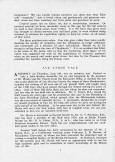|
On the day war broke out (some of you may
remember this as one of the original wireless catchphrases of comedian
Robb Wilton in the early Forties), or maybe the day before, I was
evacuated with Woodside Infants School to Brighton. It was traumatic at
East Croydon Station with children everywhere carrying gas masks in card
boxes and one very small case of belongings.
At Brighton I was assigned to a small house near the station with
several other evacuees whom I did not know. What I do remember is
sleeping in a bed with four other boys, three with heads on the headrest
and the other two top to tail - and not enough to eat. I hated it, and
the school that we shared with local children - they attended at 6.30 in
the morning
and we had the late shift until 6.30 at night. Understandably, the
children did not
like us. I was so unhappy that my parents brought me back to Croydon in
1940 just in time for the real war to start.
Living near Croydon Aerodrome we saw lots of action in those early
days when the Germans were making daylight raids. I vividly recall
dogfights overhead, planes being shot down and parachutists, one of whom
was machine-gunned on his way down. As kids we thought it as great, but
later it made me a confirmed pacifist. We liked air raids, since we did
not have to go to school if the sirens had sounded, and if in school we
had to go to the brick shelters in the playground and sing to drown the
noise!
Later the night raids came - I still get a funny feeling in my
stomach when I hear a multi-engined bomber on films or TV! I was not
scared - I do not think kids are - and I used to go out looking for
incendiary bombs and shrapnel as soon as my mother would let me and
certainly before school if the sirens had not gone off. If they had
there was no school before the
all-clear.
I remember little of Woodside School other than that we had slates
rather than paper. I do not know if this was a wartime economy or if the
school still used slates in peace time. We either spent the nights under
a steel-table shelter (my mother, blind grandmother and me) or, if my
father was not doing night work in a communal outside shelter, listening
to bombers, shells and bombs.
In late 1941 my mother and grandmother decided to leave my father
in London and we went to Lewes to escape the Blitz just as it was
ending! I went to school for two years in Lewes and enjoyed it very
much. My teacher made school interesting and played a large part in
stimulating me to learn. I recall all sorts of mental tests (I think
paper was short) and many stories on a wide variety of topics. All this
culminated in me taking the Croydon 11+ on my own in the County Hall,
while being watched intently by a very scary porter. But I seemed to do
well enough to get to John Ruskin. I think my parents tried to get me
admission to Lewes Grammar School but Croydon would not pay the fees and
my parents (father a porter at East Croydon station) certainly could not
afford them.
First Day at John Ruskin Central School
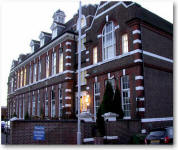 So I returned to Croydon in the summer of
1943 and in September entered form 1A of John Ruskin Central School as it was then
- pictured right on Tamworth Road. I found all
my teachers most stimulating, although looking back on it I assume they
were all older and experienced as the younger ones would have been
called up. Then in early 1944 we started to get the V1 flying bombs
(buzz bomb) attacks. These pilotless robots were
heading for London but many seemed to be a bit short on fuel. Croydon
received the highest density of bombings of all the London areas. At
first, after they had passed over we thought we were safe - the engine
cut out when the fuel ran out and they then glided to the ground and
exploded! So I returned to Croydon in the summer of
1943 and in September entered form 1A of John Ruskin Central School as it was then
- pictured right on Tamworth Road. I found all
my teachers most stimulating, although looking back on it I assume they
were all older and experienced as the younger ones would have been
called up. Then in early 1944 we started to get the V1 flying bombs
(buzz bomb) attacks. These pilotless robots were
heading for London but many seemed to be a bit short on fuel. Croydon
received the highest density of bombings of all the London areas. At
first, after they had passed over we thought we were safe - the engine
cut out when the fuel ran out and they then glided to the ground and
exploded!
If one passed over and cut
out I used to jump on my bike to see where it fell. I sometimes arrived
before the emergency services and looking back saw some horrific sights,
but to a child nothing was real. Then the Germans modified the V1s so
some turned round when the fuel ran out and that was the end of my cycle
trips. I remember particularly one that fell into the Davis
Theatre when a film was being shown and many were killed.
We did not have sirens for the V1s, and it was largely left to our
parents if we went to school or not. Fortunately, my parents made sure I
went and I enjoyed the cycle ride through the town, being careful to
miss the tram lines.
Then my father was moved to Southampton, as it turned out to help
with invasion preparations. I went to Eastleigh for a time where we were
bombed (but not hit). Then my father was moved to Poole where the
harbour was a mass of invasion vessels in a high-security area,
including all the waterfront. However, we children seemed immune from
the security - and we knew the gaps in the barbed wire - and had a great
time with the troops (many of whom were Canadians). Some of them taught
me to swim by throwing pennies into the harbour where it was relatively
shallow and getting me to retrieve them. I made quite a bit of pocket
money that way. I also did quite well in the local park. We knew where
the troops took their girls of an evening, and a search of the grass
often revealed cash (and other things) which had been lost from pockets.
After another battle with Croydon Education Committee I was
accepted at Poole Grammar School for my second year, but was placed in
form 2d (d meaning dunce in my view - primarily to sons of middle class
locals who could afford to pay the school fees for their children who
could not pass the 11+). I learnt nothing in the year I was there but
managed to come top on the basis of my previous year's schooling in
Croydon.
Victory in Europe came in May 1945 and I remember the celebrations
with bonfires and many illicit flares and thunder flashes which no
longer had military applications (although the war was still raging in
the East). My father then returned to Croydon and we followed him, only
to find that our house had been requisitioned and we had to go to court
to get the sitting tenant out - in the meantime we had to find space in
an Uncle's house as there was a massive housing shortage.
Then I returned to John Ruskin in June, just in time for the annual
examinations. I came bottom having done none of the work relative to the
examination and, as a result, was kept down for a year. This was not too
bad since I had been one of the youngest in my year anyway. I really
enjoyed JR for the next four years and did well in my School
Certificate. However, my parents could not afford to keep me at school
for the sixth form, which was just starting, and I went to work as a lab
boy at Burroughs Wellcome in Beckenham - but that is another story.
Perhaps the greatest success at JR was dancing classes one of the
teachers (Mr. Myers?) organised at lunch times. I never learnt to dance,
but it did get me to go with other classmates to Mrs. Taylor's classes
in Bridgestock Road, Thornton Heath. There I met an Old Palace Girl whom
I married in 1953 and we have been together ever since!
Post-John Ruskin Career in Chemistry
and Nuclear Science
While at Burroughs Wellcome I was allowed
time for further part-time study and went to Birkbeck College in Fetter
Lane just off Fleet Street. The building had been extensively damaged
during the war. Eventually a decision was taken to demolish it and a new
building eventually erected in Malet Street next to the main London
University skyscraper. I managed to get Inter BSc in a year and
continued to get a First Class Honours Chemistry degree in 1954. I then
stayed at Birkbeck to get a PhD in Physical Chemistry in 1956, cycling
all the time to and from Croydon- it made me pretty fit!
In the meantime, I moved from Burroughs Welcome to The Chester
Beatty Research Institute of the Royal Cancer Hospital in Kensington. I
had aspirations to read medicine, but Croydon would not give me any
financial support as I had not taken Higher Schools Certificate, and
could not afford to support myself. However, our lab was in the
forefront of research into DNA structure and I managed to meet Crick and
Watson and many of the other leaders in the field.
When I finished my PhD. I had no desire to serve in the forces and
National Service was still demanded. So I went to Harwell which was the
top nuclear site at the time. I had to stay two years to cover my
National Service Commitment but actually stayed 22! It was a great life
- plenty of
research money, being allowed to do more or less what I wanted so long
as I produced good scientific papers, and opportunities to travel the
world
attending scientific conferences and meeting top scientists. Our family
also spent two years at the University of Chicago on an exchange, during
which
we visited 40 of the 50 States. A little research was also undertaken in
my spare time, leading to more scientific papers.
On return to Harwell I was rather disillusioned by the move
to "commercial"
work, and almost took up a job as deputy head of the Australian nuclear
programme. But the Harwell Director put me off by telling me the really
top jobs were only available to Australians (our previous Director had
been an Australian!). As a result, I decided if I could not beat them I
would join them so I went into the commercial side of the business as
a project
director. I decided that Harwell's skills were appropriate for the growing
business of dealing with chemical and other environmental disasters, and
set up a Hazardous Wastes Service and the National Chemical Emergency
Service.
Both were highly successful and now form the main work area of what is
left of our nuclear programme.
In 1978 I decided that I wanted a new challenge and joined the
Civil Service to run the national programme relating to air, water and
waste issues within the Department of the Environment. This meant I was
telling the nuclear industry what to do with its waste and authorising
disposals and storage. This was not appreciated by the nuclear industry
as I knew too much of the inside story! I ended my career as Director
and Chief Inspector of Her Majesty's Inspectorate of Pollution in 1991,
and met The Queen who decorated me with the Order of Companion of the
Bath in 1990.
Afterwards I undertook consultancy services for five years, and
became director of three large companies. At the age of 65 I finally
decided to drop all serious work and enjoy life. This I have been doing,
and have travelled most of the world in the process. Upon retiring from
the civil service, I also became visiting Professor of Environmental
Technology at Manchester University.
Thanks to JRGS for all skills I learnt at the time that stood me in
good stead.
Incidentally, what is to be done in the long term with The Mill's
so extensive records? It would be a shame if they are lost to posterity.
Does Croydon have any repository for historic records?
Francis "Fetsus" Feates, Benson,
Wallingford, Oxfordshire. March 2008
Email
Mike Etheridge (JRGS
1963-65) adds: What a remarkable story from Frank. In particular
I found his war experience most interesting as it reminded me of my
family's tales about evacuation away from Croydon in the early years
of the war, and the attacks by the flying bombs in the latter part
of the war. (My twin sisters went to Cropwell Bishop in Nottingham,
my older brother, Ron, to the West Country - he ran away from his
foster home!)
Mike Marsh (JRGS
1949-55) adds: Just to jog the memories, The Alumni may be
interested in these pictures of East Croydon Station as it used to
be when I was at school and undoubtedly as Frank Feates knew it. He
must have left school just as I was joining it.
The B&W one on the left was from the Thirties; the colour
one is from the Eighties, before it was "refurbished".
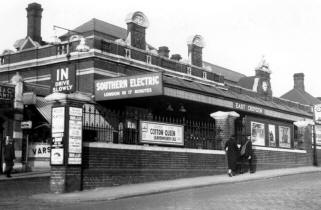 |
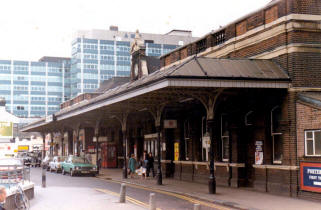 |
Re-reading through all the war-time
memories of Croydon and of the old school in Tamworth Road has evoked
some nostalgia for me this afternoon, so thanks to all the contributors.
Looking at the list of sites where the Doodle Dugs landed was
interesting and told me that there were a cluster which fell around
where I was living at the time in Shirley. I did remember some falling
although I did not know exactly where, but was not aware that there had
been any quite so close as the list suggests! It could have been during
one of the periods when I was sent away to live in Somerset with
grandparents. There were some V2 rockets landing somewhere nearby whose
destructive power was much greater, and you never heard them coming.
I attended two schools during those periods down in the west
country. I was only seven when the war ended, so neither would have been
for any great period of time since I was also attending Monks Orchard
School in Shirley when I was back home. Nevertheless, I do remember both
schools, at least one of which was using slates to write on. One was in
Dorset actually and I think that was the one I only went to for a very
short period of time.
Looking at my mother's Identity Card shows that she was living in
Beaminster (Dorset) in 1943, which was the year I started school, and
she then moved to North Perrott (Somerset) in1944, which was the school
I remember most. It is still there although is now a private cottage so
it couldn't have been very big as a school, but then the village was not
very large.
I did attend Monks Orchard during the war because I can remember
the air raid sirens sounding and we had to go along to the shelter,
which was the cloakroom with a reinforced concrete roof. That school is
still there and in use.
My father stayed in Croydon and worked at two places during the
war. One was at Creed's round the corner from the East Croydon railway
station, and the other was at RAF Kidbrook. Between them his was
considered to be a reserved occupation, so he did not go into the Forces
although he did belong to the Home Guard.
When I started at JRGS in 1949, Mr. Myers was teaching French
for at least some of my time although Mr. Fisher also taught me.
In my last year, which took up one term at Shirley Road, I was taught
Spanish by Mr. Richardson (Bon). I seem to remember Mr. Myers
also teaching Latin in my early years although it was Mr. Rees
who finished my short and not very illustrious three years struggling
with that language.
Francis "Fetsus" Feates
replies:
It is great to realise the JRGS site gets such a good readership,
and so quickly. The contribution from Mike Eldridge was particularly
interesting as we have a copy of Croydon Courageous, which was
published by The Croydon Times very soon after the war. I think
it is the first edition of Mike's booklet as the material inside is
similar, but the cover has been updated. I also have the flying bomb map
which was an insert. It is quite horrifying to look at it again and
wonder how we survived with just windows broken and ceilings down.
The other Mike's photos of East Croydon also brought back memories.
I recall my father carrying very heavy cases for passengers and tying
parcels with string - he taught me the method I still use for knotting
string round parcels. On special days I was allowed in the porter's room
- full of smoke and card players.
Paul Graham (JRGS
1959-66) adds: I also looked at the bomb damage around where I
lived in South Norwood and Anerley. It gave me a sober reminder of
why all the clusters of prefabs were in certain places.
Mike Etheridge replies: Frank
was right about the reproduction of Courageous Croydon. My
copy is a 40th Anniversary Edition see the added page below left,
with acknowledgements.
I have also attached another scan for Mike Marsh that illustrates
V1 damage to houses in Shirley Way.
ML adds: Here is an enlarged
version of the image shown above-right of Shirley Way. taken in
June 1944.
Shirley Way is located off Shirley Church Road, half a mile east of the
former JRGS site on Upper Shirley Road.
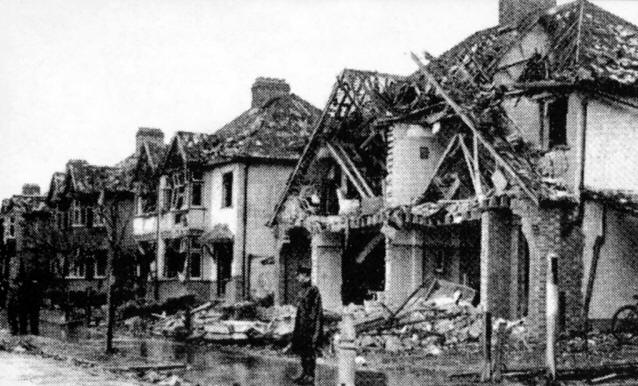 |


